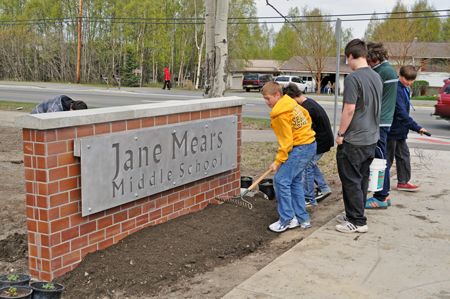Photo and Story by Josh Edge, APRN – Anchorage
Students at Mears Middle School are learning just what it takes to be the care takers of the Iditarod Trail and how important it, and other trails, are to those who live along them.
The Iditarod Trail to Every Classroom — or i-Trec — program, is aiming to give students a unique understanding of the communities along the historic 2,400 mile Iditarod Trail system from Seward to Nome.
Even though Mears Middle school may not be right along the Iditarod trail, teachers like Heather Nissen are still able to use nearby trails and other public lands as a tool to teach students.
Our projects are kind of tied into whatever we do with the public lands,” Nissen said. “We’re also learning about the Iditarod trail and how the communities are affected along the trail by what we do in our own community.”
One project that the classes are undertaking is the cleanup and maintenance of a portion of the Campbell Creek trail, from Mears to the trail head.
Student Tawny Ernest is one of the students involved in cleanup.
“We picked up the trash, which was a lot of fun because we found a lot of interesting stuff,” Ernest said. “And then we also did the creek samples on one side before the drainage pipe goes on the other.”
“And then we also did fish prints and we wrapped the trees.”
The group is wrapping some of the trees in order to protect them from the beavers that reside along the banks of Campbell Creek.
Students are also getting their hands dirty on a second project — designing and building a rain garden along the driveway leading into the school.
Kari Sherman, the Rain Garden Program Coordinator for the Municipality of Anchorage, explains what exactly a rain garden is.
“A rain garden is a garden just like any other typical garden you would see in Anchorage. But there a few things that are different. It is lower, so it can collect storm water runoff and have it pool on the surface. It’s planted with native plants, so they can survive a sort of draught and flood habitat. It has a lot of extra sand in the soil so it can drain well,” Sherman said.
The design of the garden was a team effort. Seventh grader Darby Judd is one of the students involved in the design.
“We split into groups in the class and everybody had some ideas about what they thought would be cool doing,” Judd said. “Then we came together and kind of chose different pieces from each drawing to make it into one big map.”
In addition to working on the design, seventh grade student Tory McCarthy has also been hard at work building the rain garden.
“We’ve been digging a little tunnel, well, not really a tunnel – a trench thing for the water to run down into so the plants can suck it up so the water’s not on the pavement and then less debris goes into the ocean,” McCarthy said.
For many students, this is the first time that they have taken part in any projects like this, and *they* weren’t really sure what to expect.
Teacher Janie Klueber says that these activities have received a great response from many of the 240 students involved, and have also helped them learn some new things that they didn’t know before.
“And I got some just delightful comments from the kids about, they didn’t know that there were beavers along Campbell Creek, and understanding why the beavers have to chew the trees – because it wears down their teeth, and they go after the hard wood trees as opposed to the soft woods,” Klueber said. “And realizing that the things that flow into the drain gutters in the streets when you wash your cars, all those chemicals and soapy water, they drain directly into the creek, and the kids didn’t realize that.”
This has been the pilot year for the i-Trec program and, according to Klueber, interest from other teachers has been growing.
Photo: From left, Mears Middle School seventh graders Chase Aikey, Jesse Kurtz, Max Butto, Jack Bernardy and Alex LeMatta, from the Aurora team, prepare the ground in front of the school’s sign for planting.
Download Audio (MP3)





